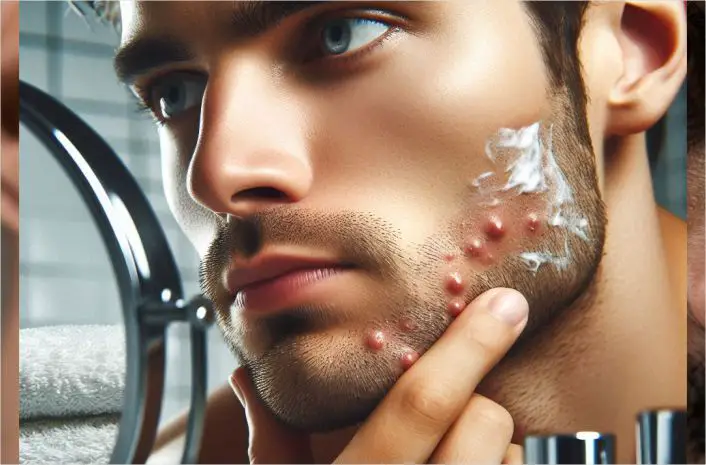Learn how to prevent razor bumps before and after shaving. Prevent ingrown hairs, and redness with the right shaving routine and skincare tips.
Shaving is one of the grooming activities for men to look sharp and confident, but it comes with some discomfort when you are not mindful of it.
Razor bumps can be painful and frustrating, but you can prevent them with the right shaving routine.
They happen when shaved hairs curl back into the skin, causing irritation and ingrown hairs.
The key is proper skin preparation, the right shaving technique, and good aftercare.
Exfoliate before shaving, use a sharp razor, and shave with the grain to reduce friction.
After shaving, rinse with cold water, apply a soothing moisturizer, and avoid tight clothing.
Want smoother skin without irritation? Follow these steps to keep razor bumps away and enjoy a clean shave every time.
Related: Recommended Skincare Products for Men
Table of Contents
- What are Razor Bumps?
- Causes of Razor Bumps
- Where Razor Bumps Appear
- Pre-Shave Preparation
- Proper Shaving Techniques
- How to Prevent Razor Bumps After Shaving
- Long-Term Prevention Tips
- When to See a Dermatologist
- Frequently Asked Questions
- Conclusion
What are Razor Bumps?
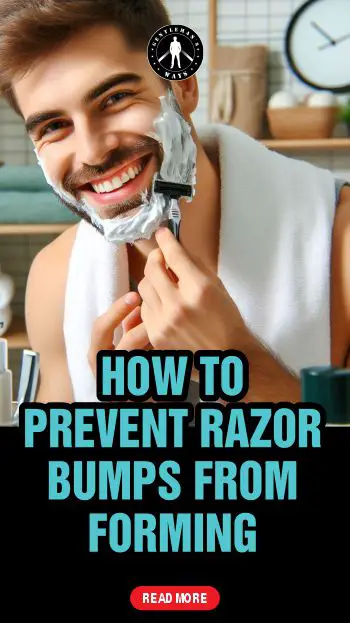
Razor bumps, or pseudofolliculitis barbae, happen when shaved hair grows back into the skin instead of outward. This causes redness, swelling, and irritation, leading to itchy or painful bumps.
They are more common if you have curly or coarse hair since the hair naturally curls back after shaving. Razor bumps can appear on the face, neck, legs, or any shaved area.
Recommended: Guide to Men’s Skincare Routine
Causes of Razor Bumps
The way you shave, the tools you use, and your skin type all play a role in the development of razor bumps.
Here is how:
1. Shaving Against the Grain
Shaving in the opposite direction of hair growth pulls the hair too short, making it easier for it to curl back into the skin. This increases the chances of razor bumps.
2. Using a Dull Blade
A dull razor tugs at the hair instead of cutting it cleanly. This uneven cut can cause the hair to grow back incorrectly, leading to ingrown hairs and irritation.
3. Dry Shaving or Skipping Lubrication
Shaving without water, shaving cream, or gel creates too much friction. This roughens the skin and makes it easier for hair to get trapped beneath the surface.
4. Having Curly or Coarse Hair
Curly and coarse hair naturally grows in a curved pattern. After shaving, these hairs are more likely to bend back into the skin, forming bumps.
5. Sensitive Skin
If your skin reacts easily to shaving, it may become inflamed and irritated. This can make razor bumps worse, especially if you don’t use soothing aftercare.
Related: How to Know Your Skin Type for Skincare
Where Razor Bumps Appear
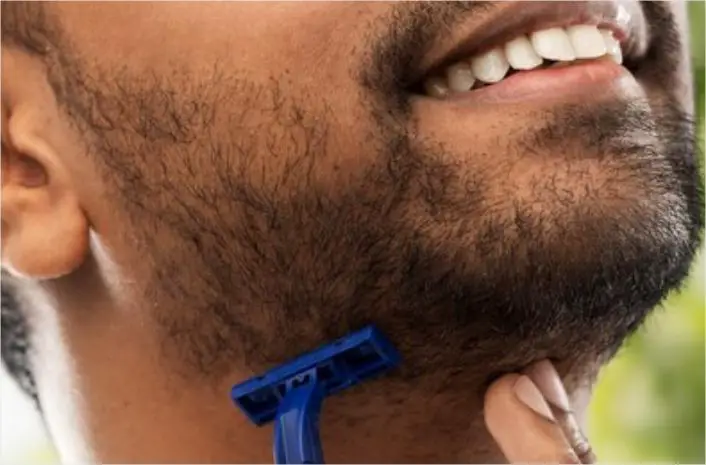
Razor bumps can show up anywhere you shave, but some areas are more prone to irritation:
- Face and Neck: Daily shaving makes these areas more vulnerable, especially for men.
- Legs: Frequent shaving can lead to bumps, especially if the skin is dry or sensitive.
- Bikini Area: The combination of coarse hair and friction from clothing makes this area a common trouble spot.
Related: Skincare Mistakes You Are Probably Making
Pre-Shave Preparation
Getting a close shave without razor bumps starts before the razor even touches your skin.
The way you prep your skin makes a huge difference in preventing irritation, ingrown hairs, and redness.
Here is what to do before shaving:
Exfoliating removes dead skin cells that trap hair, causing ingrown hairs. Use a gentle scrub or cloth two to three times weekly. This smooths your skin and helps the razor glide better.
- Exfoliate Your Skin: Exfoliating clears away dead skin cells that can trap hair under the surface, leading to ingrown hairs. Use a gentle scrub or an exfoliating cloth two to three times a week.
- Hydrate Your Skin: Dry skin increases irritation and razor bumps. Wash with warm water before shaving, take a warm shower, or use a damp towel for a few minutes to soften hair and open pores.
- Use a Pre-Shave Oil: Pre-shave oil reduces friction, creating a smoother surface for the razor. It prevents irritation, softens thick facial hair, and adds moisture, making shaving easier and more comfortable, especially for sensitive skin.
- Pick the Right Shaving Cream or Gel: A quality shaving cream or gel lubricates the skin, allowing a smooth shave. Choose products with aloe vera or shea butter. Avoid alcohol-based formulas that dry out the skin and cause irritation.
Proper Shaving Techniques
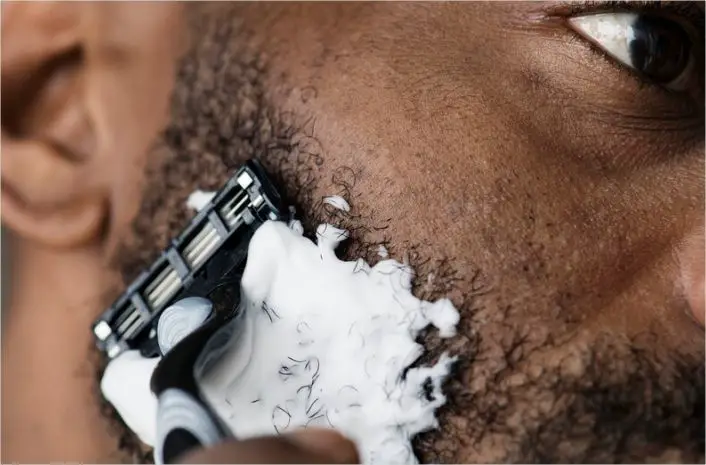
According to Medical News Today, modifying the shaving technique can help prevent bumps.
Here are some of the things to consider:
Use a Sharp and Clean Razor
A dull blade tugs at hair instead of cutting it cleanly, causing irritation and razor bumps.
Always use a sharp, clean razor to prevent bacteria buildup and get a smoother shave.
Shave in the Direction of Hair Growth
Shaving against the grain increases the risk of ingrown hairs. Identify your hair’s growth pattern and shave in that direction to reduce irritation and keep hair from curling back into the skin.
Avoid Pressing Too Hard
Applying too much pressure can irritate your skin and damage the razor blade. Let the razor glide with light, steady strokes to prevent razor bumps and unnecessary inflammation.
Limit Repeated Strokes Over the Same Area
Shaving the same spot multiple times increases irritation and the chance of razor bumps. If needed, wait a day or two before shaving the area again to let your skin recover.
Recommended: Advanced Skin Care Tips for Men
How to Prevent Razor Bumps After Shaving
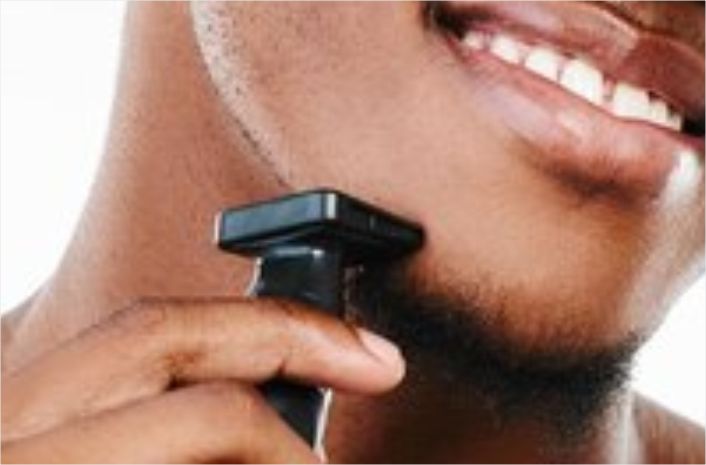
Post-shaving care plays a vital role in preventing razor bumps, ensuring a smoother, irritation-free experience.
Rinse with Cold Water
Right after shaving, splash cold water on your skin to close the pores. This helps block bacteria and debris from getting in, reducing irritation and the risk of razor bumps.
Apply a Soothing Aftershave
Use an aftershave with aloe vera or witch hazel to calm your skin. Avoid products with alcohol, as they dry out your skin and can make razor bumps worse.
Let Your Skin Breathe
Tight clothing traps moisture and heat, which can irritate freshly shaved skin.
Wear loose, breathable fabrics to help your skin recover and prevent razor bumps.
Use Anti-Inflammatory Treatments
Apply a product with salicylic acid or tea tree oil to prevent ingrown hairs. These ingredients clear hair follicles and keep hair from curling back into the skin.
Long-Term Prevention Tips
Choose the Right Razor
Switching to an electric or safety razor can help reduce irritation. Electric razors trim hair without pulling, while safety razors use a single blade that lowers the risk of razor bumps.
Use Exfoliating Skincare Products
Products with salicylic acid or glycolic acid clear out hair follicles and prevent ingrown hairs.
Regular use removes dead skin and keeps hair from curling back under the skin.
Stick to an Exfoliation Routine
Exfoliate a few times a week to prevent clogged pores and trapped hair. This helps hair grow out naturally and lowers the chances of irritation after shaving.
Keep Your Skin Hydrated
Apply a non-comedogenic moisturizer after shaving to lock in moisture and protect your skin.
Hydrated skin stays soft and flexible, making future shaves smoother and less irritating.
When to See a Dermatologist
Most razor bumps go away with proper care, but some cases need medical attention.
If you have severe irritation, redness, pain, or swelling that doesn’t improve, a dermatologist can assess whether your skin is reacting to shaving or products.
Watch for signs of infection, like pus, increased warmth, or fever. Ignoring these symptoms can lead to complications.
If razor bumps persist despite using the right techniques and treatments, a dermatologist can check for underlying skin issues.
Chronic ingrown hairs may require prescription creams or procedures. Seeking expert advice ensures you get the right treatment for long-term relief.
Frequently Asked Questions
1. How can I stop getting razor bumps?
Exfoliate before shaving, use a sharp razor, shave with the grain, and apply a soothing aftershave to prevent irritation.
2. Does shaving every day cause razor bumps?
Yes, frequent shaving increases friction and irritation. Let your skin rest between shaves to reduce razor bumps and ingrown hairs.
3. What is the best aftershave for razor bumps?
Look for alcohol-free aftershaves with aloe vera, witch hazel, or tea tree oil to soothe and prevent irritation.
4. Can electric razors help prevent razor bumps?
Yes, electric razors trim hair without cutting too close, reducing the chances of hair curling back into the skin.
Conclusion
Preventing razor bumps starts with proper skin preparation, the right shaving technique, and effective aftercare.
Exfoliate regularly, hydrate your skin, and use a sharp razor to reduce irritation.
Shave with the grain and apply soothing treatments after shaving to keep your skin smooth.
Avoid tight clothing to let your skin breathe and prevent friction. If razor bumps persist despite these steps, consider switching to a different razor or using exfoliating skincare products.
In cases of severe irritation, infections, or recurring ingrown hairs, consulting a dermatologist can help.
Following these tips consistently will lead to a comfortable, bump-free shave.
Pyo Merez is a men’s lifestyle enthusiast and writer about the gentleman’s place and impact on society. Raised by a distinguished gentleman dad, he offers unique insights into how the mind of a gentleman works and how societal norms shape gentlemen’s identity and vice versa.
Through his insightful articles, Pyo taps into the depths of gentleman culture to provide perspectives on etiquette and manners in modern society.

